| Examples of instruments I've intonated |
Steel stringed guitar, Levin
|
| The very first instrument I intonated was a steel
stringed Levin guitar with a relatively low action. The bridge was very slightly slanted. Thanks to the low action the compensations are hard to notice in the picture, but each string is compensated to its correct length. Under each string the bridge is built up with small bulges of light curing composite material so that the string height is unaltered. At the nut it so happened that the second, fifth and sixth strings needed equal compensation. The fretboard was cut off 1.5 mm and the string grooves on the first, third and fourth strings were routed back to their correct positions. |
Steel stringed guitar, Yamaha
|
| Here is a steel stringed Yamaha guitar with normal
action. Same strings as on the Levin guitar seen above. Here the bridge is much more slanted and too thin to accommodate the compensations. The third string was shortened and the rest of the strings were lengthened. I had to build big bulges of composite to support the strings. On the pictures thin lines shows the release points. At the nut the second string needed to be shortened 0.9 mm. The fretboard was cut off 0.9 mm and the other string grooves were routed back to their correct positions |
Electric mandolin, Fender
|
| The sensitivity of the ear is amazing. Notice that the
adjustment screws in the saddles are placed beside the strings. Therefore the bridges are
slanted by the string tension. That subtle slant was actually noticeable to the ear (!) and
made it impossible to get the same pitch within the string pairs. Bad design. I adjusted
the saddles so that one string noted somewhat sharp and the other somewhat flat. I didn't make any alteration to the fretboard. Instead I made a new graphite nut extending over the fretboard sufficiently for each string. |
5-string banjo
| This was a tough case because the neck was heavily warped. I straightened it as much as I dared by tightening the truss rod but it was still heavily bent when I had gone as far as I dared. The action was set very low at the 22nd fret. The photo to the right will give you a good idea of the warp. Notice how deep the string grooves are cut to get normal action on the first fret. |
|
Banjo bridges are too narrow to accommodate compensations, so I designed a thicker bridge. It has two arches and no flanged feet. I believe the arches will lead the vibrations better to the banjo head and the same bridge blank can be used for different bridge heights. I call it the Sterner Arch BridgeTM. Note that the fifth string (left) is less compensated than the first string (right), even though they are in unison. Due to the fifth string starting higher up the neck, its string height is lower than the first string. Consequently it needs less compensation at the bridge. At the other end the fifth fret acts as a zero fret (with correct height actually). |
|
| The nut was first intonated to make the first fret
note correctly. The fretboard was cut off 3.2 mm and the cut off piece was glued back
behind the nut. Now, the first fret sounded all right but the note on the fourth fret of
the third string (unison with the second string) was still sounding sharp thanks to the
warped fretboard. I didn't want to cut the fretboard anymore. Instead a small piece of bone was inserted under the third string. I had the right length to make the fourth fret sound correct. Not very pretty, but the overall intonation of the instrument became far better than expected and the tone improved a lot. I should mention that I later straightened the neck by gluing a square steel tubing under the fretboard to replace the incorrect installed truss rod. |
Mandolin, Levin
This being a fine old instrument from 1951, I didn't want to alter the fretboard. Instead I made a new nut extending over the fretboard. |
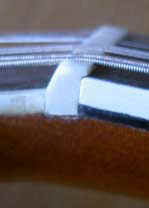 |
. |
| At the nut the second and fourth string needed to be of the same
length. The third string was a bit longer and the first the longest. The compensations at the bridge needed to be much larger than the old bridge would accommodate, so I made a new bridge top. This instrument can be changed back to original condition - if someone would like to. |
Steel stringed guitar, Michael Sandén
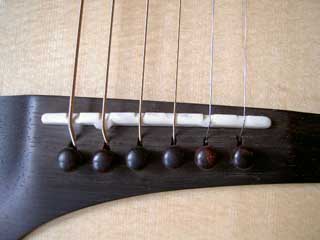 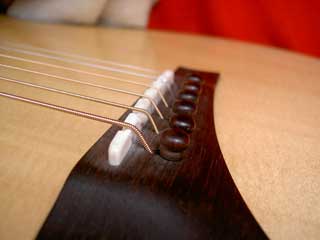 Sandén builds his guitars with an extreme angle on the strings behind the bridge saddle. This way the downward pressure from the strings (and the volume of the instrument) will increase. The compensations increase the angles even more. Notice the fifth string.
Sandén guitars have zero frets and are known to intonate well. But even a zero fret has a string height. On this zero fret the three bass strings intonated well, only 0.5 cent false. The three treble strings were 1.5 - 2 cents false. First I intonated the bridge only. But this customer (Petter Hölaas, Intelligent Sound) was not satisfied. Since early age he is blind and his hearing is extremely well trained. I had to intonate once more and pay regard to the treble strings on the zero fret. On the front side of the fret I drilled tiny holes on ech side of the strings to make fastenings for the composite material. A scary operation on such an expensive instrument. This time Petter was satisfied. |
Steel stringed guitar, Martin D35
| This Martin guitar from 1971 was bought unseen through the
Internet. The price was favourable, but the bridge had been re-glued and misplaced
about 1.5 mm closer to the soundhole. The guitar intonated very badly. Along the back of the bridge you can see the original bridge position. A new bone saddle was made, extending back over the bridge. I still had to build composite string ramps for the two heaviest strings. At the 6th string the bridge pin can't be pushed down all the way. |
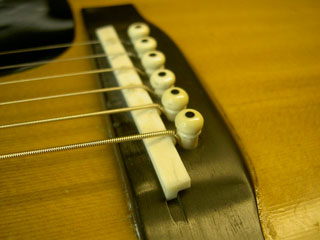 Notice that in spite of the extreme angles of the strings, the breaking force on the bridge and the saddle is little, thanks to the width of the bone. In other words a good design. |
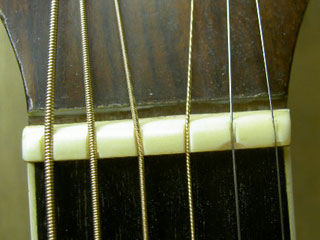 |
At the nut the fretboard needed to be cut 2.6 mm. Later the cut off part was glued back behind the nut. At the second string you can see an earlier attempt to improve the intonation. |
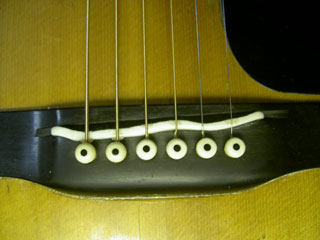 |
After the intonation the excess material was removed from the saddle to make it look less bulky. The slanted area at the front side was painted black to match the ebony bridge. The result was a wonderful sounding guitar with a somewhat original appearence. |
Steel stringed guitar, Ibanez SG10 (Stefan Grossman model)
| I was surprised that I would have to cut the fretboard as much as 1.86 mm on this guitar. I could see with my eyes that the distance from the nut to the first fret looked pretty wide, so I checked the fretboard. The distance from the nut to the first fret was 0.45 mm longer (!) than the theoretical distance. The first fret noted 4-5 cents sharp on all strings! I didn't think such faults existed in modern factory made instruments, but you learn all the time. Here is what it looked like when the cut off piece form the fingerboard was glued back behind the nut. |
|
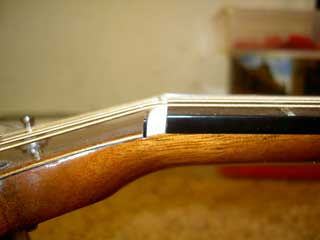 |
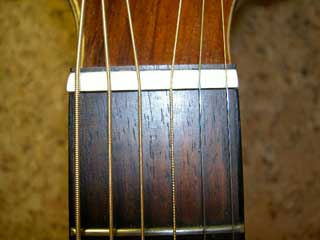 |
| On this guitar (as on Martin guitars) the bottom of the nut is angled to the same plane as the peghead. When the end of the fretboard is cut and the nut is moved, the string height increases at the nut. This can be taken advantage of to make an invisible nut compensation! Instead of calculating the correct lengh of the strings, I calculate the correct depth of the string grooves. The action at the nut becomes a tiny bit higher on some of the strings, but you won't notice the difference when you play. | |
Steel stringed guitar, Martin D35
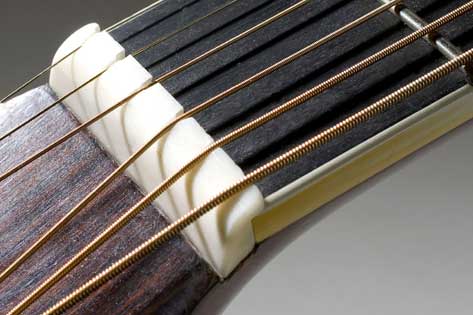 |
NEW! Extended nut. I've made a fixture so I can rout nuts that extends over radiused fretboards. This means that from now on I don't have to make any alterations at all to the instruments! |
| Extended bridge bone. I kept the back side of the bone stright for a more conventional appearence. In spite of the thick bone, there was no negative affect on the tone. It is obvious that the positive effect of the intonation outweights the possibly negative effect of the thick bridge bone. As I said before, the breaking force on the bone is reduced a lot with this design. The shadow shows the different length of the strings. | 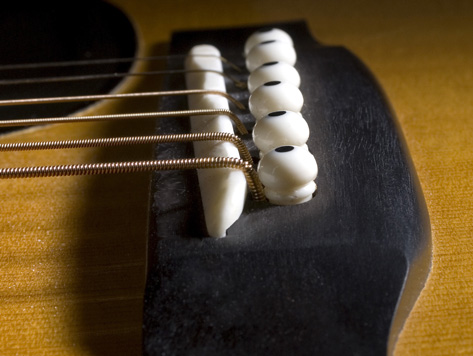 |
Acoustic bass, Martin 00C-16GTAE
|
The strings were too long at the bridge on this bass guitar. The third
string had to be shortened about 4 mm. First I tried to glue small bone
blocks on the front side of the bridge bone, but that didn't work. Most of
the pressure ended up on the front edge of the blocks, lessening the
contact with the pickup in the slot. |
Copyright © Anders Sterner
Back